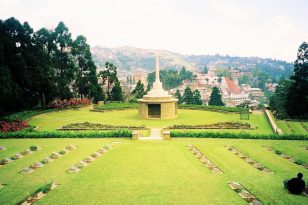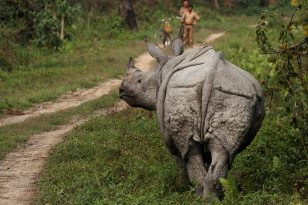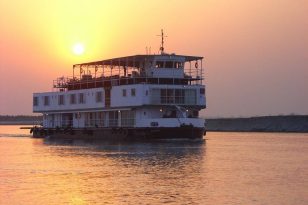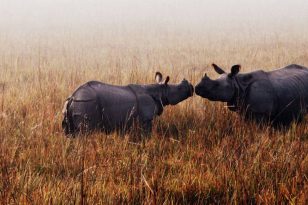| Tour Price | Land Only: £ 2795 Tour with international flights |
|
| Flights | We can arrange to book flights for you through our partner travel agent or you can arrange your own flights and we will arrange for your transfer from the place where the tour starts | |
| Number of Days | 14 | |
| Best Time to Travel | Nov-April | |
| Tour Dossier | Download Dossier | Booking Enquiry |
Overview
The tiger (Panthera tigris) is perhaps the most celebrated of the wild animals of India. It symbolises the power of nature and finds an important place in our culture, mythology and legends. It has been worshiped as the guardian and ruler of the forest. Tigers are believed to have evolved in East Asia (China) about 2 million years ago. They then dispersed to other parts of Asia. There existed eight subspecies of tiger, out of which three have gone extinct. Today this perfect carnivore is a critically endangered species, though once it roamed freely in most of Asia. India is home to the largest population of wild tigers in the world.
Destinations
Delhi → Corbett → Agra → Ranthambore → Jaipur
Detailed Itinerary
Arrive at New Delhi’s International Airport. After you finish your immigration formalities, collect your baggage and walk through the customs channel, our representative will meet you and transfer you to your hotel.
Delhi is India’s capital and a major gateway to the country, contemporary Delhi is a bustling metropolis, which successfully combines the ancient with the modern. Amidst the fast spiraling skyscrapers the remnants of a bygone time in the form of its many monuments stand as silent reminders to the region’s ancient legacy. The first impressions for any visitor traveling in from the airport are of a specious garden city, tree-lined with a number of beautiful parks.
After breakfast enjoy a tour to Old Delhi, visit Jama Masjid- one of the largest mosques in Asia. It offers an excellent view of the old city and the Red Fort. The walk then takes you through the narrow lanes and bazaars of the old city; the havelis (mansions) which still retain their traditional appearance, Jain temples, small businesses, kinari bazaar (one of the most popular bazaars in Delhi) and parathe wali gali (the street famous for fried bread).
In New Delhi visit Humayun’s Tomb, built by the widow of the second Mughal Emperor, Humayun and a precursor of the Taj Mahal. Also drive past the imposing India Gate- a war memorial, the Parliament Building and the President House, before arriving at Qutab Minar, the tallest stone tower in India.
Start early today and drive one of India’ most picturesque National Parks, Corbett. Situated in the foothills of the Himalayas, Corbett is one of India’s most beautiful wildlife areas known for its stunning landscapes, terrain, bird life, rivers flowing through it and jungle trails. This park has a tiger population of around 160, which makes it the most important sanctuary of this endangered species in India.
You will take two jeep Safaris today in two different zones in the park.
The park is famous for various animals: tiger, leopard, jungle cat, wild dog, Indian bison, sloth bear, sambar, chital, barking deer, mugger, Indian python; Birds: crested serpent eagle, great hornbill, blue-throated barbet, blue-bearded bee-eater, racket-tailed drongo, black-necked stork, great cormorant, crested kingfisher.
Corbett National Park has captured the imagination of many with its diverse wildlife and breathtaking landscapes. The natural uniqueness of the area was recognised long ago and so in 1936 Corbett attained the distinction as the first national park to be established in mainland Asia. It covers an area of 521 sq. km and together with the neighbouring Sonanadi Wildlife Sanctuary and Reserve Forest areas, forms the Corbett Tiger Reserve over 1288 sq. km.
Its geographical location between the Himalayas and the terai, and the streams, rivers and ridges crisscrossing the terrain, present Corbett with a remarkable variety of landscapes. This vivid mosaic of habitats – wet and dry, plain and mountainous, gentle and rugged, forests and grasslands – supports numerous plant and animal species, representing Himalayan as well as plains kinds. The most famous of Corbett’s wild residents are the Bengal Tiger and the Asiatic Elephant, but with about 600 species of avifauna Corbett is one of the richest bird regions of India.
Take a birding walk today in the buffer area for some birding opportunities. The different habitat types of Corbett i.e. mountains, sal forests, chaurs, khair-sissoo forests, and rivers have their distinct assemblage of plants. More than 600 species of trees, shrubs, herbs, bamboos, grasses, climbers and ferns have been identified in the Park.
In the afternoon, visit another part of the forest for an interesting nature walk and crossing the river on a bamboo raft for a short ride.
Drive back to Delhi today after a leisurely breakfast. Arrive by noon and check in. Rest of the day can be spent exploring the local bazaars or visiting the famous Lodi garden.
This is undoubtedly the best way to spend an evening in Delhi. These are pleasant green spaces in Delhi – with some labelled trees to help visitors become familiar with the Indian flora. The area was used as a burial for Delhi’s (pre-Mughal) Sayyid and Lodi rulers. Mohammad Shar’s tomb (1450) can be seen as a predecessor for architecture of Humayun’s tomb and Sikander Lodi’s tomb (1571) is set within a walled enclosure and clearly related to Humayun’s tomb garden. The domed mausoleums appear to have been sighted in an open landscape, rather as the ancient Greeks placed temples. The building of monumental tombs runs against the principles of Islam and it is probable that Delhi’s Turkish Sultans brought the idea from Persia to India. Lodi Gardens are therefore a good place to reflect on the origins of Mughal garden design.
In the morning leave for Agra to explore the Taj Mahal, a monument dedicated to love. After you have checked in rested for a while, start your tour of the city that includes visit to the Taj and the fort.
The Taj Mahal is everything that has been said about it and more. Taking 22 years and 20,000 men to build, the white marble was quarried 200 miles away and was transported to the site by a fleet of 1000 elephants. Built by the Mughal emperor Shah Jahan as an expression of his love for his wife Mumtaz Mahal, in mid-17th century, the Taj Mahal is truly one of the wonders of the world. Though the Taj appears to be amazingly perfect from almost any angle, it is the close-up marble inlay work, which is really astounding.
Later visit Agra Fort – the seat and the stronghold of the Mughal empire under successive generations. This was the seat of Mughal rule and administration and the present structure owes its origins to Akbar who erected the walls and gates and the first buildings on the eastern banks of Yamuna river. Shah Jahan added the impressive quarters and the mosque while Aurangzeb added the outer ramparts. Visit its hall of public audience and its royal pavilions.
(Agra-Bharatpur-60 kms, 1½ hrs, Bharatpur-Ranthambore- 4 hrs train)
Post Breakfast drive to Bharatpur. En-route visit Fatehpur Sikri, the deserted red sandstone city, built by the Great Mughal Emperor Akbar as his capital and palace in the late 16th century. It was abandoned soon after it was built when the local wells went dry and it remains today in much the same condition that it was over 300 years ago. It is complete with palaces and mosques and used to be a town larger than London when it was originally constructed. Now it is an extraordinary place to wander around with its buildings in near perfect condition.
Also stop at Bharatpur Bird Sanctuary. The Keoladeo National Park or Keoladeo Ghana National Park formerly known as the Bharatpur Bird Sanctuary in Rajasthan, is a famous avifauna sanctuary that sees thousands of rare and highly endangered birds such as the Siberian Crane come here during the winter season. Over 230 species of birds are known to have made the national park their home. It is also a major tourist centre with scores of ornithologists arriving here in the hibernal season. It was declared a protected sanctuary in 1971. It is also a declared World Heritage Site.
Migratory waterfowls visit the Park in hordes during the month of October. The most noticeable waterfowls coming to the park are the bar-headed & grey lag geese. Predatory birds like the imperial eagle, steppe & tawny eagle, spotted eagle, marsh harrier & laggar falcon are attracted towards the park. Birds like the kingfisher, red-vented & white cheeked bulbuls, babblers, partridges, sunbirds, sparrows, parakeets & orioles live in bushes & burrows. These winged beauties make this park an ornithologist’s delight. In the afternoon enjoy tri-cycle ride through National park.
Later connect a short train to Sawai Madhopur, the gateway to Ranthambore national park.
Dinner & overnight stay at the lodge.
Ranthambore Tiger Reserve is one of the biggest and most famous tiger reserves of India. Famous for its tourist friendly and most photographed tigers, this reserve offers a wide variety of wildlife which includes tiger, leopard, sloth bear, hyena, caracal, jungle cat, desert cat, desert fox, jackal, blue bull, Indian gazelle, spotted deer, common langur, marsh crocodile, python etc. It also hosts a rich birdlife which covers almost 300 different species of migratory and resident birds that includes some of the very beautiful water birds. The park is dotted with many lakes or water bodies, most of them are man- made. These lakes are part of prime habitat for the royal predator and always there is a fight between resident and transient tigers to claim this supreme territory. The park is also dotted with ruins of medieval period and it is most rewarding to observe the king of the jungle using these remnants of the past as their resting place.
Enjoy morning & afternoon Safaris.
Jaipur, the pink city was founded in 1727 AD by Maharaja Jai Singh II who ruled from 1699-1744. Initially his capital was Amber, which lies at a distance of 11kms from Jaipur. After several battles with Marathas, Jai Singh was keen on the security aspect of the city. Due to this reason, he focused on his scientific and cultural interests to make a brilliant city. Being, a lover of mathematics and science, Jai Singh sought advice from Vidyadhar Bhattacharya, a Brahmin scholar of Bengal, to aid him design the city architecture. Vidyadhar referred the ancient Indian literature on astronomy, books of Ptolemy and Euclid, and discussed the plan with the King.
Take an excursion to Amber fort to see the fabulous Amber Fort. Before the City Palace was constructed in Jaipur, Amber was the seat of power. The fort is surrounded by fortified battlements and overlooks the Moat Lake. Ruins and remains are spread over the Aravalli hills and sprawling crenulated walls lattice the surrounding area. An elephant (alternatively by jeeps) will spare you the trouble of reaching up to the fortress. Once on top, take a stroll through the sprawling complex of courtyards and halls. Many of the rooms have delightful wall paintings, with precious stones and mirrors inlaid in the walls. Most fascinating, perhaps, is the Sheesh Mahal (hall of mirrors) where a single lamplight is reflected in the many mirrors, lighting up the room.
On the way back from Amber Fort you will stop and see the `Palace of Winds’, otherwise known as Hawa Mahal. It is really an elaborate facade behind which the ladies of the court used to watch the daily goings on in the street below. It is extremely intricate in its pink sandstone carving. The cool wind blows through its facade of windows and latticed screens through which the queens of the court once viewed the streets of the city.
Also visit the City Palace, which is an overwhelming complex of exquisite palaces, gardens and courtyards, decorative art and carved doorways. The palace museum houses collections of rare manuscripts, armory, costumes, carpets and miniature paintings. In the evening stroll around the colorful markets of Jaipur.
Return to your hotel later for overnight stay.
In the morning drive to Delhi for your late afternoon flight back home.
Inclusions & Additional Information
- All meals as mentioned above
- All transportation
- All entrance fees
- All transfers
- Bottled water
- All other day to day activities as mentioned above
- International Flights
- Visa
- Travel/medical Insurance
- Alcoholic beverages, soft drinks, snacks between meals
- Camera and video charges in the Parks
- Local tips
Food is Indian food, local cuisine, Continental and Chinese. If you have any dietary requirements, please mail us at the time of the booking and we will take care wherever possible.
In the Assam plains, the days are going to be warm and evenings cooler, and you can expect a few showers in April. Carry jackets and fleece.
A passport (with at least six months remaining validity) and a current Indian visa are required for this trip. Please note that you are required to have a passport with a machine-readable bar code. You will need to apply for your Indian visa in advance from the relevant issuing authority in your home country. British Passport holders can apply for an e-Tourist Visa, a single entry visa valid for 30 days. Please visit the website https://www.hcilondon.in/pages.php?id=28
You must take out appropriate insurance to cover personal accident, medical costs, repatriation, loss of baggage and holiday cancellation.
Please visit your GP for guidance for vaccinations while travelling to India. Please also visit this website for more details https://www.fitfortravel.scot.nhs.uk/destinations/asia-(east)/india.aspx
The currency used is Indian Rupee. It is recommended to get your money exchanged on arrival at Delhi airport.
